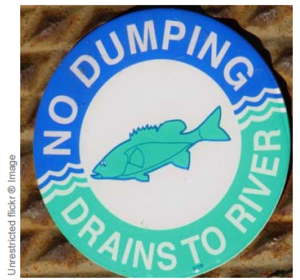
MS4 fact sheet - Storm Drain Stenciling
Contents
Storm Drain Stenciling
Developing a storm drain stenciling program
Storm drains are gateways that allow pollutants in stormwater to flow untreated from local streets to lakes, rivers and streams. Residual oil, grease, solids, antifreeze, cigarette butts, yard waste, plastic and other wastes found on roads, parking lots and driveways pollute downstream waters by increasing phosphorus levels, reducing oxygen levels and ultimately impairing aquatic habitat for fish and other organisms as well as drinking water sources.
An unfortunate, yet still common, misperception is that storm drains discharge to water treatment plants. Stenciling is one public education tool that helps dispel this misperception. This fact sheet provides guidance on implementing a storm drain stenciling program to increase public awareness of the direct connectivity between storm drains and water resources.
Benefits / Pollution Reduction
Storm drain stenciling will help the people in your community understand what happens to polluted stormwater. When people are aware of the negative environmental impacts of their actions, they are more likely to stop dumping pollutants down storm drains. Reduction in the discharge of pollutants into storm drains results in cleaner downstream lakes, streams and wetlands. It contributes to improved water clarity, coloration and odor as well as fish and wildlife habitat.
Program Development & Implementation
Programs designed to increase public awareness through volunteer efforts have the benefit of educating both the general public and the volunteer. The extent of an MS4’s storm drain stenciling program is dependent upon several factors including the MS4’s available resources, size of staff, and degree and character of its illicit storm drain discharges. Many pollution prevention awareness phrases can be effective: “No Dumping. Drains to River,” “No Dumping. Drains to <Insert Water Source>,” “You Dump It, You Drink It,” “No Waste Here,” and “Only Rain in the Drain.” For more information regarding other methods to trace and prevent illicit discharges see the Potential Discharge Identification and Risk Reduction fact sheet.
Storm Drain Stenciling Techniques
Storm drain ‘stenciling’ can be done with paint and stencils, medallions, pre-stamped grates or stamped concrete.
Paint Painting or spray painting with a paper, plastic or metal stencil as a guide is an inexpensive application for storm drain stenciling and easily implemented by volunteers. However, the lifetime of the paint may not exceed two years. Stenciling can be done on the street in front of the storm drain, on the adjacent sidewalk, or on the curb. Spray paint is the easiest to apply neatly, but contains air polluting propellants. Consider using environmentally-friendly paints free of heavy metals and low in volatile organic compounds.
Medallions Plastic, ceramic or metal medallions, typically 4 inches round, can be glued with a strong epoxy or embedded in concrete and bolted down. Gluing medallions is easily transferrable to volunteer programming.
Pre-stamped grates Pre-stamped grates will last a long time (until the metal is worn down) and are an effective means to implement a city-wide storm drain stenciling initiative.
Stamped concrete While concrete is still wet, stamp an impression of the selected ‘no dumping’ slogan. Stamped concrete will last longer than paint or medallions. In addition, concrete stamps allow versatility in design since, unlike medallions, long-term stability is not based on size of the design.
